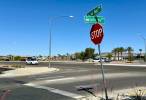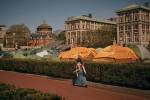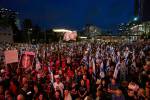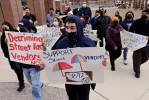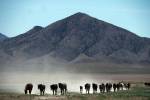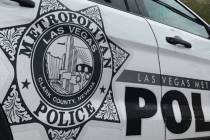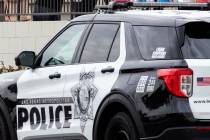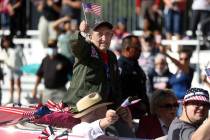The end of the city: Southwest valley now Las Vegas’ great urban laboratory
Every Las Vegas native, it seems, has a version of the story where they remember Sin City ending at this or that street. Beyond lay the implacable desert. For most long-timers on the west side of the Valley, Rainbow Boulevard is that street. These stories are filled with childhood nostalgia, a longing for a smaller and simpler city. (You might hear the corollary anecdote about being able to get across town in 20 minutes.)
For those of us who are more recent arrivals, such stories tend to evoke terse, thin smiles. This earlier, smaller Vegas sounds — I’m sorry to say — kind of awful. Parochial and boring, with nothing to do outside of visiting tacky casinos, this older Vegas always struck me as an inert outpost at the edge of the American consciousness, about to be swallowed by a vast and hostile Mojave Desert.
But though I cling to my sense of self as a “more recent arrival,” the truth is I’ve been here since 2006. I’m not such a recent arrival anymore. I know this because I now have my own end of the city story, too. 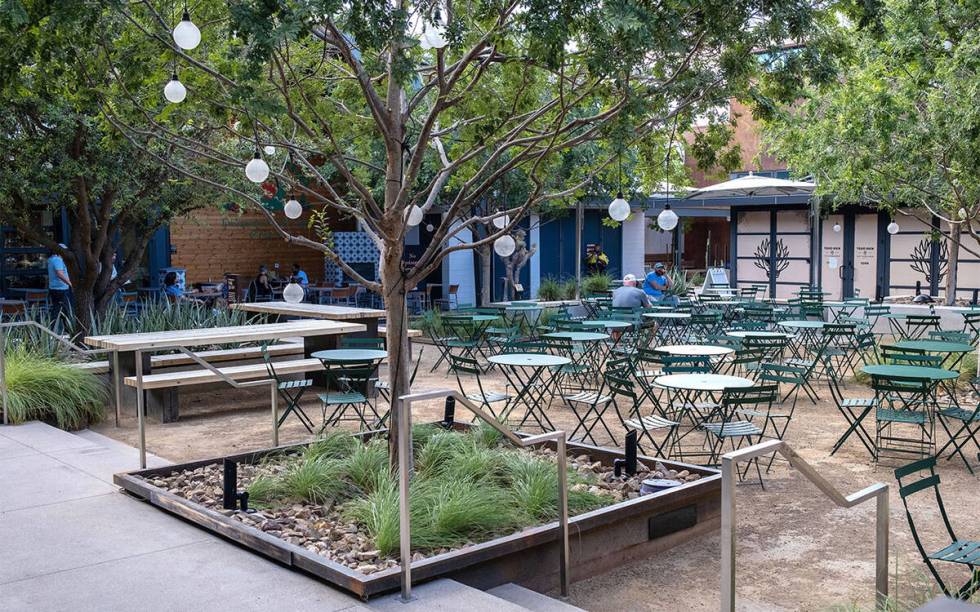
I’ve lived in the southwest valley since 2007 — well beyond Rainbow, in fact at the base of the Desert Hills that demarcate — or ought to demarcate — the western edge of the Las Vegas Valley. You can’t go any further out, right? For years that was kind of true. But now, if you slip around the edge of those hills, there’s a ton of new construction near Blue Diamond. Homes and storage facilities where once were just detention basins, trails and the raw desert. I guess my own “flat and inert” version of Vegas includes the cave on Pyramid Hill, now filled in, or the ease of taking a bike through the subterranean detention channels — which are harder to access now. I miss the days when builders would park a fleet of earth movers and bulldozers in the desert for weeks, and you could climb around on them when no one was looking.
And, dammit, even as late as the aughts you really could get anywhere in town in 20 minutes. I’m routinely late these days because I can’t quite recalibrate the clock.
My wife, Nicole, and I are always waxing romantic about those classic American neighborhoods of gentrified, bougie style: Adams Morgan in Washington, D.C. Half of Brooklyn. Logan Square in Chicago. Lower Highlands in Denver. Northern Liberties in Philadelphia. The list goes on and on, but basically it’s all the same vibe: vintage homes with tons of character, walkable streets, an independently owned coffee shop. A used bookstore or two. Maybe a park with some tall trees. (Of course, these neighborhoods are swiftly becoming unaffordable.)
Las Vegas largely lacks such neighborhoods, and by the time you get out to the edges of the Valley, it’s barely possible to even imagine what such a neighborhood might look like here. We have the hills and a smattering of palm trees and that’s about it. It’s a 10-minute walk just to leave my subdivision. Our “main street” is a single strip mall with a PT’s Pub, a gas station with an ice cream counter, a Jack in the Box and an Italian sandwich shop.
We’ve all watched Las Vegas grow into a more well-rounded city — the Smith Center, the sports stadia, new casinos, new attractions. Post-Covid, we’re luring sports teams, winning titles, planning high-speed rail, building a Sphere. And hoping there’s enough water to keep the party going. Vegas feels cool now and still — barely — affordable. 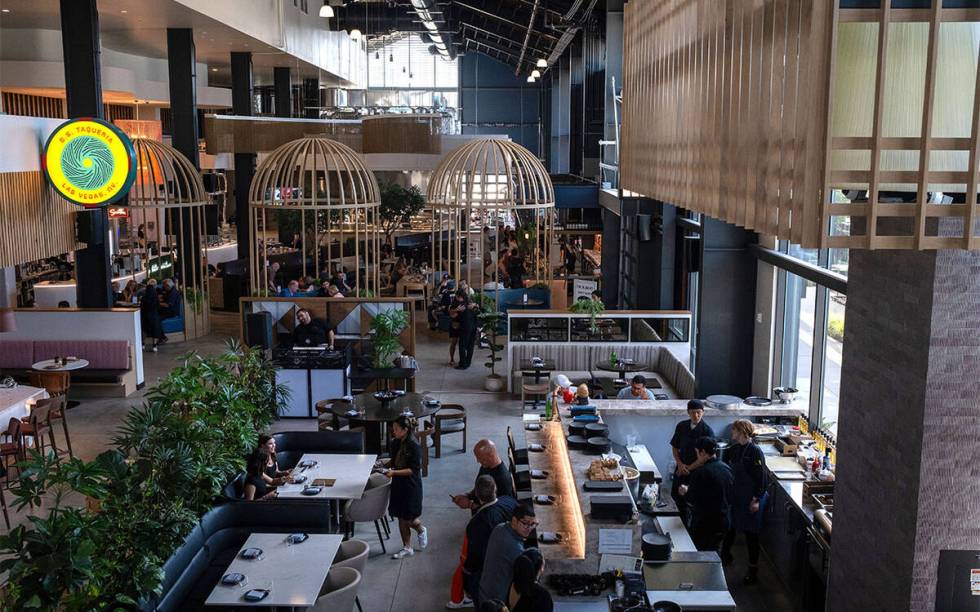
What’s surprising is that these changes are now sprouting in my out-of-the-way corner of town. There’s a baby Chinatown on South Rainbow. Suddenly those cool restaurants and hangouts that marked the Arts District are popping up down here. And massive new developments around the 215 Beltway curve have given this whole end of town a newfound energy. Could it be that what we’ve always desired is now all around us? That Southwest Las Vegas, our ‘hood,has suddenly become the hippest neighborhood in town? LOL.
Las Vegas is less a city of neighborhoods and more a city of … sides and corners. So where exactly is the “southwest side of town”? I’ve seen news reports mention sites east of Interstate 15 and, on the west side, as far north as Sahara. That’s basically the whole of the townships of Spring Valley and Enterprise, a definition so broad as to become almost meaningless. Instead, how about we define the Southwest Valley (complete with Capital Letters) as everything west of Jones and south of Tropicana? Even that’s debatable — no Southern Highlands, no Silverton — which goes to show how nebulous and homogenous our sense of place in Las Vegas really is.
At any rate, as you get west of Rainbow and south of Russell or Sunset, you’re really squarely “there.” If you Google-mapped the Valley in satellite view, the bottom left corner of the map still reads like undiscovered country, a patchwork of housing developments and strip malls interspersed with huge, square-mile chunks of desert. It’s filling in fast, but in spots there’s an almost rustic, lone-ranch-home-on-two-acres vibe, the last remnants of an older, rural town.
Maybe the neighborhood began in 1996, when Jim Rhodes acquired 950 acres in what the Las Vegas Sun described at the time as the “remote southwest Las Vegas Valley.” For years his development, Rhodes Ranch, was Southwest Las Vegas. Then came the hospitals, Southern Hills (2004) and St. Rose Dominican’s San Martín campus (2006). The vast master-planned community Mountain’s Edge broke ground in 2004. For a decade, as the city weathered the Great Recession, changes were incremental: The extension of Fort Apache. Stoplights in place of stop signs. New development at Rhodes Ranch. A strip mall here or there. Wet ’n’ Wild (now Cowabunga Canyon) opened in a spot wedged up against the Desert Hills in 2013.
But the population kept growing. If we take the township of Enterprise as a crude approximation for the Southwest (its boundaries stretch much farther east than my proposed Southwest Valley, across Interstate 15, and, yes, include both Southern Highlands and the Silverton), the area’s population in 2000 was less than 15,000. By 2010 it was 108,000. In 2020, it had risen to 221,831.
In the 2010s, the headquarters of both the UFC and datacenter company Switch, along with a plethora of car dealerships, sprouted up along Interstate 215 in the Southwest Valley. And the region (amalgamating research for both Spring Valley and Enterprise) became one of the most ethnically diverse in the country.
But the broad, empty curve of the 215, slicing east-west to north-south between Durango and Sunset, lingered. If you liked cities and wanted to see what Las Vegas could do outside its downtown and resort corridor, this was one of the places you were curious about. You couldn’t help but imagine a little city-within-a-city, densely filled with shops, restaurants, offices and parks. As long as that stretch sat vacant, the Southwest felt somehow vacant too. 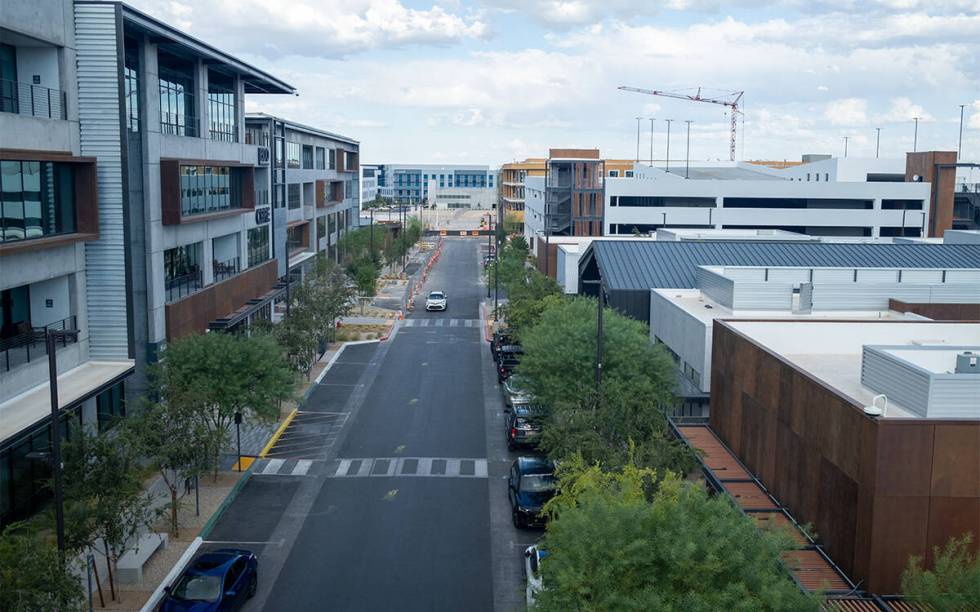
The first idea out the gate was Sullivan Square, at the northeast corner of 215 and Durango. According to the website VegasTodayAndTomorrow.com, Sullivan Square — named for famous Chicago architect Louis Sullivan — was planned to be a 16.5-acre, billion dollar mixed-use project offering a mix of “brownstones, terraces, high-rise condominiums, lofts and live/work space.”
The project flamed out during the recession but laid a spiritual foundation for what this corner of town could become. In 2014, the New York-inspired Gramercy opened, another mixed-used development of apartments, office space and restaurants. IKEA opened in 2016 at the northwest corner of 215 and Durango, and that — till now — served as the area landmark. Where do you live? Around the corner from the IKEA. Offices and apartments and parks did fill in, and developers pushed their shovels right to the base of the Desert Hills nearby.
But the neighborhood has accelerated in the post-Covid world and begun to feel like its own place, not just an exit on the way to Summerlin. Evora, another mixed-use project of offices, residential and restaurants, is partially open near Patrick and Buffalo. The long-awaited Bend development — a sleekly designed collection of bars and restaurants (and a pickleball complex), just north of IKEA — is finally under construction.
The marquee development in the Southwest is Durango Casino & Resort, the first in a new generation of Station Casino properties. For as long as I’ve lived in this corner of town, there’s been a sign promising a giant hotel casino. Visible now for miles, the $780 million, 15-story casino-hotel, slated to open in late November, may really put the 215 corridor on the map just as an earlier generation of high-rises marked the southern half of Downtown Las Vegas as more than just moribund space between The Strat and Fremont Street.
But, surprisingly, there’s an even more expensive project across the street. The $850 million UnCommons appears poised to not only define the Southwest Valley but hint at what a more urbanized Las Vegas could look like.
Under construction since 2020 and with two more years to go, UnCommons at full build-out will include more than 800 residential units and 500,000 square feet of office space, plus a conference and event pavilion, a high-end cinema, a fitness center — and more than two dozen restaurants, most of which are already open.
UnCommons does away with references to Manhattan or Chicago or anywhere else in favor of a stripped-down palette of precast concrete and oxidized steel. It will spread out across 40 acres, but the scale is low, just four stories. It’s not big, but there are streets and pedestrian scale. The complex and its centerpiece food hall, the bright and spacious Sundry, offer an unpretentious yet stylish post-industrial vibe.
It’s the promise of urbanism. Or a kind of urbanism — something urban-lite, like downtown Tempe or Scottsdale, Denver’s Cherry Creek, downtown Bethesda, and so on. Walkable: Yes! At least for a handful of blocks.
Matter Real Estate Group, the developer behind UnCommons, previously developed Town Square at the south end of Las Vegas Boulevard. But Jim Stuart, a partner with Matter, reminded me that UnCommons is less a Town Square (or Downtown Summerlin) 2.0 and more a reconsideration of the office park, a building typology that gets very little attention in this town. The Strip casinos, after all, are not just our primary hotels. They’re really our primary office buildings.
The question Stuart and his colleagues explored was what would make someone want to come to work in a post-Covid environment where most of us would just as soon stay at home. “We build homes with garages that people pull into not to see their neighbors,” he says. “We build office buildings that are vertically organized so that you show up, you get in an elevator, you go to the top floor not to see anybody, unless you bump into them on your way back to your car. This is not what society wants any longer.”
UnCommons was designed by the L.A. office of the blue-chip international firm Gensler (which also master-planned CityCenter). “Our thesis at that time was for all the weight and might of Gensler in creating sense of place, they were not equipped to study and understand sense of belonging, which is a much different conversation,” Stuart says. “So we brought in cultural anthropologists, neuroscientists, we brought in health care experts, and started to ask a bigger question, which is, what is our role?”
The answer: to provide an alternative for a community and a culture, that has, at least anecdotally, been feeling more and more isolated and lonely.
Stuart tells me he met his wife at a San Gennaro Feast in a parking lot. “It’s the stimulus of the place and the energy of a place and how that place makes you feel,” he says. “That is not architecture per se. Now, architecture has a role, but that role is to respond to a human condition. That’s where we have failed. Architects get classically trained. They reference iconic architectural structures. They think their mission at hand is to create a visually appealing building.”
The desire, Stuart explains, is to create a “Class A” experience, rather than a generic “Class A” office building. There is, of course, a very real limit to this incarnation of urbanity. It is polished and cool. It is diverse and inclusive. It looks good. But it’s not cheap. The shops here are more aspirational than practical. This is not a place to drop off your dry cleaning. And you still have to drive to get there.
Projects like UnCommons, ultimately, will need context to reach their full potential. Can developers of adjacent parcels add their own spin (infill townhomes with ground level retail, a plaza for food trucks, small office space with lofts above), transforming isolated developments into true nodes? The lesson of UnCommons isn’t the lineup of great chefs and eateries — though that certainly is fun. It’s simply this: It doesn’t take that much to turn a chunk of desert into a real space. The development’s central courtyard is, designwise, unadorned and simple. It’s not that large. There’s no giant “attraction” commanding your attention. But already it’s the single coolest place to hang out on this side of town.
The fabric of the Las Vegas Valley is essentially suburban. But it’s densely suburban — and that’s probably the practical goal Las Vegas should work toward. The Valley is small, so there’s far less of a drop off in density and the flavor of urbanism between edge and core that defines every other major American city.
Unless we want to leap the mountains and start building developments on the road to Pahrump, we need to imagine what a denser city might look like. What’s happening in the Southwest could be an indication of changes throughout the Valley. There is no reason other hubs of walkable activity can’t be built. There’s plenty of space along 215 and along I-15. There are shuttered casinos, underperforming strip malls in the center of town. There’s land everywhere. These won’t be neighborhoods, exactly, in the traditional sense. But they could be places of architectural distinction, places to gather, places to feel proud about, places to care for. Yes, we’ll still have to drive to them. But maybe one will open close enough to ride a bike to.
And hopefully Las Vegas, whatever its future holds, will always end at the mountains. ◆




